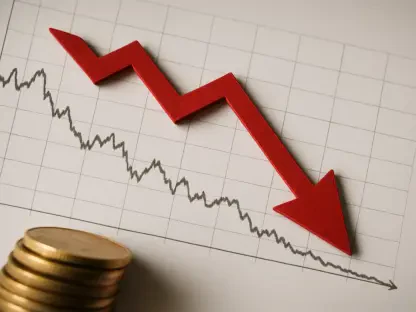As the global economy navigates through an era of unprecedented challenges, recent insights from leading economists paint a troubling picture of what lies ahead, with a staggering 72% anticipating a significant slowdown in growth over the coming year, driven by deep-rooted systemic disruptions. This alarming consensus emerges not from fleeting issues but from trade tensions, technological upheavals, and policy uncertainties that are converging to create a fragmented world where regional disparities are more pronounced than ever. Emerging markets show glimmers of potential, while advanced economies grapple with stagnation and inflationary pressures. This stark contrast raises pressing questions about the sustainability of current economic models and the urgent need for innovative solutions. Delving into the structural challenges, regional divergences, and key disruptors, a clearer understanding of this complex scenario begins to take shape, highlighting the critical crossroads at which the global economy stands.
Structural Challenges Reshaping the Economy
Long-Term Disruptions in Key Sectors
The global economic slowdown is driven by structural shifts rather than temporary setbacks, with long-term challenges fundamentally altering the way economies operate across critical sectors. Economists point to natural resources and energy as areas of significant concern, where scarcity and transition pressures are creating bottlenecks for industrial output and sustainability goals. Similarly, technology and innovation are rapidly transforming economic interactions, often outpacing the ability of institutions and businesses to adapt. Trade and global value chains face unprecedented fragmentation, as geopolitical tensions and policy shifts disrupt established networks. Moreover, global economic institutions are struggling to maintain relevance in a world of diverging interests, necessitating a reevaluation of their roles. These disruptions are not mere cyclical downturns but represent a profound reorganization of economic foundations, demanding new strategies for resilience and cooperation among nations and industries to address these persistent challenges effectively.
The Need for Adaptive Leadership
Addressing these structural disruptions requires a bold rethinking of leadership and international collaboration, as traditional approaches fall short in the face of such complex, interconnected issues. The urgency to transform economic turbulence into sustainable strength has never been greater, with calls for innovative governance models that prioritize adaptability over rigid frameworks. This involves fostering dialogue between public and private sectors to align on shared goals, particularly in areas like technology integration and resource management. Furthermore, policymakers must navigate the delicate balance of mitigating immediate economic pain while laying the groundwork for long-term stability. Without such adaptive leadership, the risk of prolonged stagnation or even systemic collapse looms large, especially as global challenges transcend national borders. The emphasis on resilience means preparing for unexpected shocks by building flexible systems that can withstand disruptions in trade, energy, or finance, ensuring economies are not caught off guard by future uncertainties.
Regional Disparities and Economic Divergence
Emerging Markets as Growth Engines
Amid the gloomy global outlook, emerging markets stand out as beacons of potential, offering a counterpoint to the struggles of advanced economies. Regions such as the Middle East and North Africa, South Asia, and East Asia and the Pacific are identified as key drivers, with a significant number of economists expressing optimism about their strong performance in the near term. These areas benefit from demographic advantages, increasing digital adoption, and strategic investments in infrastructure that fuel economic momentum. While challenges like political instability and resource dependency persist, the ability of these markets to attract foreign investment and diversify their economic bases sets them apart. Their growth trajectories suggest a shift in global economic power, where traditional hubs may need to recalibrate their strategies to remain competitive. This dynamic underscores the importance of tailored policies that nurture these emerging engines while addressing vulnerabilities that could derail their progress.
Struggles of Advanced Economies
In stark contrast, advanced economies face a much bleaker economic horizon, burdened by a combination of weak growth, inflationary pressures, and fiscal constraints that limit policy maneuverability. In Europe, moderate inflation and fiscal easing offer little relief against a backdrop of sluggish expansion, while the United States contends with high inflation despite monetary policy adjustments. Public debt has emerged as a growing concern, with risks once associated with developing nations now increasingly prevalent in these wealthier regions. This shift in risk profiles complicates efforts to stimulate growth, as fiscal limitations hinder large-scale interventions. The structural nature of these challenges means that quick fixes are unlikely to suffice, pushing policymakers to consider deeper reforms in labor markets, taxation, and public spending. As these economies grapple with internal pressures, their global influence may wane, necessitating a focus on innovation and efficiency to regain economic footing in a rapidly changing world.
Navigating Toward a Sustainable Economic Future
Lessons from a Fragmented Landscape
Reflecting on the turbulent economic environment of recent times, it becomes evident that fragmentation and divergence have carved deep divides between regions and sectors. Trade disruptions have rippled through global value chains, exposing vulnerabilities that few anticipated in their full scope. Advanced economies have stumbled under the weight of debt and inflation, while emerging markets have shown resilience despite their own set of hurdles. The structural challenges in technology, energy, and institutional frameworks have proven to be more than temporary obstacles, reshaping economic priorities on a fundamental level. Each region has faced unique struggles, yet the interconnected nature of global systems means that no economy stands isolated from the broader turmoil. These lessons underscore the critical need for a shift in perspective, recognizing that old models of growth and cooperation have reached their limits in addressing the complexities of a fragmented world.
Building Resilience Through Collaboration
Looking ahead, the path to economic stability hinges on fostering global collaboration to address the systemic issues that defined past struggles. Nations must prioritize joint efforts in reforming trade policies to reduce disruptions and ensure equitable access to resources. Investing in technology that bridges regional disparities can create a more inclusive economic framework, while shared commitments to sustainable energy practices offer a way to mitigate resource constraints. Policymakers should also focus on strengthening international institutions, equipping them with the tools to navigate modern challenges effectively. Beyond these measures, building fiscal buffers in advanced economies will be crucial to weather future shocks, while supporting growth in emerging markets through targeted aid and investment can balance global progress. By embracing these strategies, the global community can transform past turbulence into a foundation for a more resilient and sustainable economic future.









